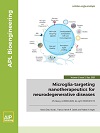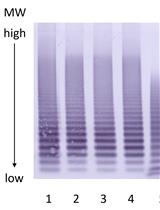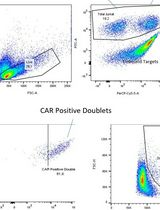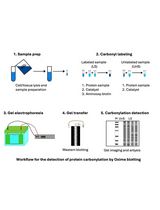- EN - English
- CN - 中文
A Novel Method to Make Polyacrylamide Gels with Mechanical Properties Resembling those of Biological Tissues
一种制备具有类似生物组织力学性能的聚丙烯酰胺凝胶的新方法
(*contributed equally to this work) 发布: 2021年08月20日第11卷第16期 DOI: 10.21769/BioProtoc.4131 浏览次数: 5394
评审: Alessandro DidonnaSourav S PatnaikAnonymous reviewer(s)
Abstract
Studies characterizing how cells respond to the mechanical properties of their environment have been enabled by the use of soft elastomers and hydrogels as substrates for cell culture. A limitation of most such substrates is that, although their elastic properties can be accurately controlled, their viscous properties cannot, and cells respond to both elasticity and viscosity in the extracellular material to which they bind. Some approaches to endow soft substrates with viscosity as well as elasticity are based on coupling static and dynamic crosslinks in series within polymer networks or forming gels with a combination of sparse chemical crosslinks and steric entanglements. These materials form viscoelastic fluids that have revealed significant effects of viscous dissipation on cell function; however, they do not completely capture the mechanical features of soft solid tissues. In this report, we describe a method to make viscoelastic solids that more closely mimic some soft tissues using a combination of crosslinked networks and entrapped linear polymers. Both the elastic and viscous moduli of these substrates can be altered separately, and methods to attach cells to either the elastic or the viscous part of the network are described.
Graphic abstract:

Polyacrylamide gels with independently controlled elasticity and viscosity.
Background
Biological tissues are viscoelastic materials that combine features of elastic solids and viscous fluids. Different tissues contain different amounts of the components that contribute to both viscosity (e.g., hyaluronic acid) and elasticity (e.g., collagen fibers), and their structure and proportion change during pathological processes. The widespread use of elastomers or hydrogels as substrates for cell culture (Pelham and Wang, 1997) has revealed the strong impact of substrate mechanics on cell structure and function and focused attention on the limited view of cell biology derived from studies of cells on traditional glass or plastic substrates (Janmey et al., 2020). Until recently, studies of cellular response to substrate or matrix stiffness only examined how cells respond to elastic modulus alterations, with the viscous contribution being either neglected or uncontrolled. Theories of cell mechanosensing have also generally focused on the elastic resistance of the substrate. These limitations were largely due to the lack of suitable materials in which viscosity can be systematically varied within a viscoelastic substrate. There now exist three general approaches for introducing viscous dissipation in a viscoelastic substrate. In one, a polymerizing and crosslinking system, like a polyacrylamide gel, is designed to produce a network near the threshold of the sol-gel transition, such that there are significant elastic properties but also significant viscosity (Cameron et al., 2011). A second method forms crosslinked polymer networks with two classes of crosslinkers: one is covalent and static and the other is non-covalent and dynamic. These first two classes of material are viscoelastic fluids, or viscoplastic material, meaning that if subjected to constant stress, they can deform without limits, as the crosslinks or entanglements rearrange to minimize energy in the deformed state (Chaudhuri et al., 2016). The third class of material, which is the topic of this report, is viscoelastic solids. These materials dissipate substantial energy when they are deformed and slowly continue to deform in response to constant stress; however, eventually, they reach a steady state of deformation (strain) that depends on the magnitude of stress but not on the duration that it is applied. A detailed description of the differences between viscoelastic liquids and solids and a summary of how these three classes of material are constructed are provided in Chaudhuri et al. (2020).
Synthetic polyacrylamide (PAAm) hydrogels are widely used as a model system to study the effect of tissue elasticity on its behavior in health and disease (Beningo et al., 2002). PAAm can be easily tuned to the range of stiffness that reflects the physiological environment of cells, i.e., from hundreds of Pascals up to tens of kilo Pascals. While the role of tissue elasticity in cell biology has been powerfully illustrated, little is known about the viscous aspect of tissue mechanics and how it determines cell structure and fate.
Upon polymerization, polyacrylamide hydrogels create a nearly purely elastic network, with a viscosity several orders of magnitude smaller than the elasticity (Basu et al., 2011). While many reports focus on controlling the elastic properties of hydrogels, our aim was to develop a strategy to introduce and control the viscosity in a viscoelastic network. Our protocol describes the preparation of high molecular weight linear polyacrylamide chains, which can be subsequently sterically entrapped in the crosslinked polyacrylamide network to serve as a viscous component of the gel that dissipates energy. This strategy allows the independent tuning of both the elastic and viscous properties of the hydrogel using the same chemical components as for the preparation of purely elastic polyacrylamide hydrogels. Moreover, it is possible to attach adhesive ligands using classical crosslinkers that can be bound to only the viscous part of the hydrogels (linear polyacrylamide chains), the elastic part of the hydrogels (polyacrylamide network), or both the elastic and viscous elements (as presented in Figure 1).

Figure 1. Illustration of the three methods to make viscoelastic gels presenting adhesion proteins. (1) Linear PAAm, where activated linear PAAm is used for the gel mix preparation; (2) the elastic network of crosslinked PAAm, where unactivated linear PAAm is mixed with an appropriate acrylamide/bis-acrylamide solution and NHS-acrylate monomers; or (3) both types of PAAm, where an unactivated gel mix is prepared and sulfo-SANPAH is used post-polymerization.
Materials and Reagents
18-mm diameter glass coverslips (Menzel-Glaser, VWR, catalog number: MENZCB00190RA020)
6-well plates (Corning, Fischer Scientific, catalog number: 07-200-83)
Pipette tips
50-ml glass bottle
1.5-ml and 0.5-ml conical tubes (Eppendorf, catalog numbers: 00030 120 086; 00030 121 023)
Aluminum foil
0.1 M NaOH (Sigma-Aldrich, catalog number: 211465, store at room temperature)
(3-Aminopropyl)trimethoxysilane (3-APTMS) (Sigma, catalog number: 281778, store in a hood at room temperature)
Glutaraldehyde (Sigma, catalog number: 340855; store at 4°C)
SurfaSil Siliconized Fluid (Thermofisher Scientific, catalog number: TS 42800; store at room temperature)
Acetone (Sigma, catalog number: 179124; store at room temperature)
Methanol (Sigma, catalog number: 322415; store at room temperature)
40% acrylamide solution (Bio-Rad, catalog number: 1610141; store in a hood at 4°C)
2% bis-acrylamide solution (Bio-Rad, catalog number: 1610142; store in a hood at 4°C)
TEMED (Bio-Rad, catalog number: 1610801; store in a hood at room temperature)
Ammonium persulfate (APS) powder (Bio-Rad, catalog number: 1610700; store desiccated at room temperature)
Acrylic acid N-hydroxysuccinimide ester (NHS-acrylate) (Sigma, catalog number: A8060; store at -20°C)
Sulfo-SANPAH (sulfosuccinimidyl 6-(4′-azido-2′-nitrophenylamino)hexanoate) (Sigma, catalog number: 803332-50MG; store at -20°C)
Dimethyl sulfoxide (DMSO) (Sigma, catalog number: 472301; store at room temperature)
HEPES (50 mM pH 8.2) (Sigma, catalog number: 83264; store at room temperature)
Phosphate-buffered saline (PBS) (Sigma, catalog number: 806552; store at room temperature)
MiliQ water
Protein of interest, e.g., collagen I (Corning, catalog number: 354236) or fibronectin (MP Biomedicals, catalog number: MP215112601)
Equipment
250-ml glass beaker
Set of micropipettes (from P1 to P1000)
Coverslip mini-rack
Shear rheometer (e.g., Malvern Instruments, Kinexus stress-controlled rheometer)
Tweezers
Chemical hood
4°C refrigerator
-20°C freezer
Incubator set at 37°C
UV light source at 320-365 nm
Centrifuge at 10,000 × g
Desiccator
Procedure
文章信息
版权信息
© 2021 The Authors; exclusive licensee Bio-protocol LLC.
如何引用
Pogoda, K., Charrier, E. E. and Janmey, P. A. (2021). A Novel Method to Make Polyacrylamide Gels with Mechanical Properties Resembling those of Biological Tissues. Bio-protocol 11(16): e4131. DOI: 10.21769/BioProtoc.4131.
分类
细胞生物学 > 基于细胞的分析方法 > 细胞粘附
生物化学 > 蛋白质 > 电泳
您对这篇实验方法有问题吗?
在此处发布您的问题,我们将邀请本文作者来回答。同时,我们会将您的问题发布到Bio-protocol Exchange,以便寻求社区成员的帮助。
Share
Bluesky
X
Copy link













